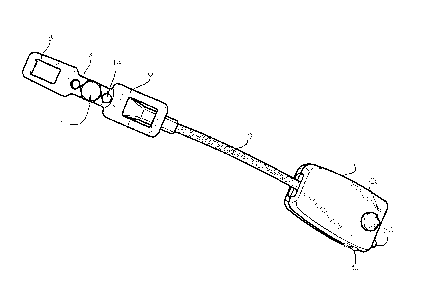Some of the information on this Web page has been provided by external sources. The Government of Canada is not responsible for the accuracy, reliability or currency of the information supplied by external sources. Users wishing to rely upon this information should consult directly with the source of the information. Content provided by external sources is not subject to official languages, privacy and accessibility requirements.
Any discrepancies in the text and image of the Claims and Abstract are due to differing posting times. Text of the Claims and Abstract are posted:
| (12) Patent: | (11) CA 2995211 |
|---|---|
| (54) English Title: | VEHICLE SAFETY DEVICE |
| (54) French Title: | DISPOSITIF DE SECURITE POUR VEHICULE |
| Status: | Deemed Expired |
| (51) International Patent Classification (IPC): |
|
|---|---|
| (72) Inventors : |
|
| (73) Owners : |
|
| (71) Applicants : |
|
| (74) Agent: | GOWLING WLG (CANADA) LLP |
| (74) Associate agent: | |
| (45) Issued: | 2022-07-26 |
| (86) PCT Filing Date: | 2016-08-11 |
| (87) Open to Public Inspection: | 2017-02-16 |
| Examination requested: | 2021-08-09 |
| Availability of licence: | N/A |
| Dedicated to the Public: | N/A |
| (25) Language of filing: | English |
| Patent Cooperation Treaty (PCT): | Yes |
|---|---|
| (86) PCT Filing Number: | PCT/US2016/046577 |
| (87) International Publication Number: | WO 2017027719 |
| (85) National Entry: | 2018-02-08 |
| (30) Application Priority Data: | ||||||
|---|---|---|---|---|---|---|
|
A seat belt extender comprises a rotatable member having multiple blades of different sizes that engage the receptacle mounted to the vehicle. At the opposite end of the seat belt extender is a receptacle that receives the blade that is connected to the seat belt and/or seat belt and shoulder harness.
Rallonge de ceinture de sécurité comprenant un élément rotatif pourvu de multiples languettes de différentes tailles qui s'emboîtent dans la boucle montée dans le véhicule. Une boucle, à l'extrémité opposée de la rallonge de la ceinture de sécurité, reçoit la languette qui est reliée à la ceinture de sécurité et/ou au harnais.
Note: Claims are shown in the official language in which they were submitted.
Note: Descriptions are shown in the official language in which they were submitted.

2024-08-01:As part of the Next Generation Patents (NGP) transition, the Canadian Patents Database (CPD) now contains a more detailed Event History, which replicates the Event Log of our new back-office solution.
Please note that "Inactive:" events refers to events no longer in use in our new back-office solution.
For a clearer understanding of the status of the application/patent presented on this page, the site Disclaimer , as well as the definitions for Patent , Event History , Maintenance Fee and Payment History should be consulted.
| Description | Date |
|---|---|
| Letter Sent | 2024-02-12 |
| Letter Sent | 2023-08-11 |
| Inactive: Grant downloaded | 2022-07-27 |
| Inactive: Grant downloaded | 2022-07-27 |
| Grant by Issuance | 2022-07-26 |
| Letter Sent | 2022-07-26 |
| Inactive: Cover page published | 2022-07-25 |
| Pre-grant | 2022-06-07 |
| Inactive: Final fee received | 2022-06-07 |
| Notice of Allowance is Issued | 2022-02-07 |
| Letter Sent | 2022-02-07 |
| Notice of Allowance is Issued | 2022-02-07 |
| Inactive: Approved for allowance (AFA) | 2022-02-04 |
| Inactive: Q2 passed | 2022-02-04 |
| Advanced Examination Determined Compliant - PPH | 2022-01-04 |
| Amendment Received - Voluntary Amendment | 2022-01-04 |
| Advanced Examination Requested - PPH | 2022-01-04 |
| Letter Sent | 2021-08-19 |
| Request for Examination Received | 2021-08-09 |
| Request for Examination Requirements Determined Compliant | 2021-08-09 |
| All Requirements for Examination Determined Compliant | 2021-08-09 |
| Common Representative Appointed | 2019-10-30 |
| Common Representative Appointed | 2019-10-30 |
| Amendment Received - Voluntary Amendment | 2018-06-26 |
| Amendment Received - Voluntary Amendment | 2018-06-26 |
| Change of Address or Method of Correspondence Request Received | 2018-06-11 |
| Inactive: Cover page published | 2018-04-05 |
| Inactive: First IPC assigned | 2018-03-05 |
| Inactive: Notice - National entry - No RFE | 2018-02-26 |
| Inactive: IPC assigned | 2018-02-21 |
| Inactive: IPC assigned | 2018-02-21 |
| Inactive: IPC assigned | 2018-02-21 |
| Application Received - PCT | 2018-02-21 |
| National Entry Requirements Determined Compliant | 2018-02-08 |
| Application Published (Open to Public Inspection) | 2017-02-16 |
There is no abandonment history.
The last payment was received on 2021-08-06
Note : If the full payment has not been received on or before the date indicated, a further fee may be required which may be one of the following
Please refer to the CIPO Patent Fees web page to see all current fee amounts.
| Fee Type | Anniversary Year | Due Date | Paid Date |
|---|---|---|---|
| Basic national fee - standard | 2018-02-08 | ||
| MF (application, 2nd anniv.) - standard | 02 | 2018-08-13 | 2018-05-24 |
| MF (application, 3rd anniv.) - standard | 03 | 2019-08-12 | 2019-07-22 |
| MF (application, 4th anniv.) - standard | 04 | 2020-08-11 | 2020-07-08 |
| MF (application, 5th anniv.) - standard | 05 | 2021-08-11 | 2021-08-06 |
| Request for examination - standard | 2021-08-11 | 2021-08-09 | |
| Final fee - standard | 2022-06-07 | 2022-06-07 | |
| MF (patent, 6th anniv.) - standard | 2022-08-11 | 2022-08-05 |
Note: Records showing the ownership history in alphabetical order.
| Current Owners on Record |
|---|
| ANGEL NOGUERA |
| Past Owners on Record |
|---|
| None |